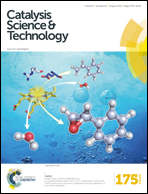Elucidation of the high CO2 reduction selectivity of isolated Rh supported on TiO2: a DFT study†
Abstract
Methanation and reverse water-gas shift reaction are two important reactions that could happen simultaneously during the process of CO2 reduction. Exploiting new catalysts with high selectivity towards one single process is highly desirable. It has been shown that isolated-Rh/TiO2 can selectively generate CO rather than CH4. A molecular level understanding would provide more insight into catalyst design for CO2 reduction. In the present contribution, the density functional theory method was employed to study the CO2 reduction reaction by H2 based on a Rh1/TiO2 (101) model. The co-adsorbed CO2 and H2 on the Rh atom can react with each other to form CO. The inhibition of further H2 adsorption on the CO pre-adsorbed Rh atom stops the following sequential hydrogenation of CO. This can explain the experimentally observed high selectivity of Rh1/TiO2 to CO. Different co-adsorption properties can be understood by the frontier orbital charge density symmetry matching principle. The same method has been extended to other metal systems (Ru, Pd and Pt) to identify candidate catalysts with high selectivity for CO2 reduction. Similar adsorption properties of isolated Pd with Rh may induce high selectivity towards CO. These results are expected to provide a prediction to find new selective catalysts for CO2 reduction.


 Please wait while we load your content...
Please wait while we load your content...